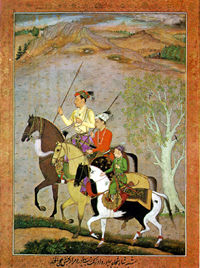
Shuja, Aurangzeb, and Murad Bakhsh: Mughal Miniature, 38.7 x 26 cm. c. 1637. Attributed to Balchand. Coll: British Museum. (Click image for a large view.)
The four sons of the Mughal Emperor , Shah Jahan, all laid claim to the throne when their father fell seriously ill in 1658. Each had considerable administrative experience and military skills, each commanded a considerable military force, and each had a loyal following. Dara Shikoh (1615-58), the eldest son, was resident at Shah Jahan’s court as the designated heir; Shuja was Governor of Bengal, Bihar, and Orissa; Aurangzeb governed the Deccan; and Murad was Governor of Gujarat and Malwa. Dara’s forces were defeated by Aurangzeb, who occupied the imperial capital of Agra; and Aurangzeb took his own father prisoner. Shuja’s army was routed in battle; and Murad was lured into a false agreement and taken prisoner. Dara eventually collected together another force, suffered defeat as before, and once again he fled; but soon he was betrayed by one of his allies, and handed over to his brother. Accused of idolatry and apostasy from Islam, Dara was condemned to death, and the sentence was carried out on the night of 30 August 1659, one year after Aurangzeb took over the Fort at Agra and assumed the throne. Aurangzeb delivered the head of his brother to their father.
Aurangzeb Alamgir (“World Conqueror”), whose reign lasted for forty-nine years until his death in 1707, conducted vigorous military campaigns to extend the frontiers of the vast Mughal empire which he had inherited. Both in the northwest and northeast, the imperial armies gained ground, but the losses, which were very considerable, drained the treasury. Already under his father, the revenue of the crops had been raised from a third to a half, and the extensive and interminably long military campaigns he waged required him to keep the peasantry heavily taxed. Some notable victories were likewise achieved in the Deccan. Aurangzeb retained Shahjahanabad as his capital, but after some two decades the capital, in a manner of speaking, shifted to wherever Aurangzeb would set camp during his long military campaigns, which in the Deccan alone lasted some 26 years and perhaps cost him his life. Aurangzeb’s mobile army consisted of some 500,000 camp followers, 50,000 camels, and 30,000 war elephants; and when this gargantuan force moved, bands of Maratha guerrillas would strike the rear, attacking the stragglers and fleeing with booty.
A considerable part of Aurangzeb’s energies were consumed in keeping his numerous opponents at bay, and he had to deal with the Rajputs, the disloyalty of his son Akbar, and the Sikhs, whose leader, Guru Tegh Bahadur, was killed at Aurangzeb’s command when he refused to convert to Islam. Neither could Aurangzeb forgive the Sikhs for having supported his brother and principal rival, Dara. (There is another, though related, view of the question of Dara’s relationship to the Sikhs: it is not so much that the Sikhs supported Dara, but rather they sheltered him, given that they were bound to the principle that they were obligated to give asylum to whoever came seeking their assistance). The most effective opposition to Aurangzeb’s rule, however, came from the Marathas, whose chief, Shivaji, could not be contained. Only Shivaji’s premature death at the age of 53, in 1680, appeared to offer the Mughal Emperor some relief, but that very year the Rajputs of Jodhpur and Mewar forged an alliance against Aurangzeb and declared themselves free from his sovereignty. The army that Aurangzeb sent under his son Akbar to subdue them was formidable, but the emperor had perhaps not reckoned with his son’s traitorous conduct. However, Akbar, who had rather vainly declared himself the emperor, was compelled to flee to the Deccan, where he enlisted the help of Shivaji’s son, Sambhaji. Aurangzeb decided to take to the field himself, and eventually drove his own son into exile in Persia, from where Akbar never returned. The Sultanates of Bijapur and Golconda were also reduced to utter submission, and Sambhaji was captured in 1689 and tortured before being murdered.
Towards the end of his reign, Aurangzeb’s empire began to disintegrate, a process which would be considerably accelerated in the years after his death, when “successor states” came into existence. Aurangzeb’s harsh treatment of Hindus, and the reversal of the liberal religious policies of his predecessors, particularly Akbar, have been cited as principal reasons for the disintegration of his empire. [For a more detailed consideration, see the accompanying article on “Aurangzeb and the Encounter with Religion.”] More likely, the peasantry was bled to death, and the system of political alliances established by Akbar was allowed to go to seed. The empire had become far too large and unwieldy, and Aurangzeb did not have enough trustworthy men at his command to be able to manage the more far-flung parts of the empire. Many of the his political appointees broke loose and declared themselves independent, and Aurangzeb’s preoccupation with affairs in the Deccan prevented him from meeting political challenges emanating from other parts of the empire. Shortly after the death of Aurangzeb, the Mughal Empire ceased to be an effective force in the political life of India, but it was not until 1857-58, when the Indian Rebellion was crushed and the Emperor Bahadur Shah was put on trial for sedition and treason, that the Mughal Empire was formally rendered extinct.
Further Reading:
Richards, John. The Muhgal Empire. Cambridge: Cambridge University Press, 1993; Indian ed., Delhi: Foundations Books, 1995. New Cambridge History of India, I:5.
See also the notes to the accompanying piece, “Aurangzeb, Akbar, and the Communalization of History“.

